| Tick Patrol HLFS Ursprung 2006 |
|
| Home | |
| Abstract | |
| Motivation | |
| Ticks | |
| The Hunt | |
| Laboratory Analysis | |
| Assignment | |
| Video | |
| Bibliography | |
| Team | |
| Imprint | |

![]()
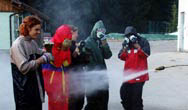 |
|
| Decontamination after each foray. The cleaner assures that none of the brave tick hunters carry the tiny foe home in their protective clothing. |
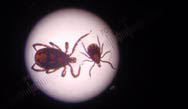 |
|
| In order to assure that no members of the team are in danger of infection the pathogens are killed off in 70% alcohol. |
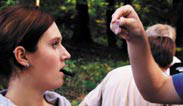 |
|
| Larva, nymph or adult? |
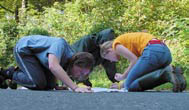 |
|
| Sharp eyes were needed to catch the tiniest creatures. |
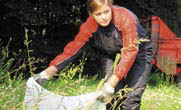 |
|
| Ticks are attracted to odor. Eva always caught the most! |
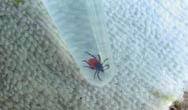 |
|
| The ticks were now stored in 70% alcohol. |
Ticks
General Information
Ticks are blood-sucking parasites found all over the world, which live on the blood of their hosts. As a transmitter of diseases in humans and animals they have unquestionably obtained much infamy. A harmless tick bite from a tick infected with disease-causing microorganisms can result in great danger. The bacteria or viruses harbor in the intestines or the salivary gland of the tick. These disease-causing microorganisms can be transmitted into the body of the victim.
Ticks belong to the class of arachnids, or more precisely, they are a type of parasitic mite. They need the blood of other living things to survive.
Ticks need much more blood than other parasites. In the most extreme case they have to stay on their host for fifteen days to obtain enough blood. This is why it is especially important for the ticks to be able to go undetected and to cling tightly to the host's skin.
Occurrences
The most wide spread opinion is that ticks drop down from trees when they detect a possible host passing by, but this assumption is not true. Ticks actually tend to lurk on low lying vegetation such as twigs or the ends of leaves. They climb onto blades of grass or underbrush up to 1.5 m high and wait for a host to pass by.
Ticks prefer to live in areas of the forest bordering on meadows, clearings, stream- or river flood plains. plantations with underbrush and hedges, areas between deciduous and coniferous-, timber and coppice forests.
Ticks tend to avoid dry and cold seasons when searching for hosts. In most habitats the search is most intense in spring and early summer and less intense at the height of the summer.
Lifecycle
The life cycle of a tick consists of three stages: larva, nymph and adult.
The larva hatches out of an egg. This occurrence is hardly visible to the naked eye, because the larva is only 1mm in size. Larvae feed on the blood of small rodents like mice, porcupines and birds; they therefore pose no threat to humans. Aside from their size an important characterisic of the larva is the number of legs. In contrast to the later stages, the larva only has three pairs of legs.
After it has obtained it's first blood-meal the larva molts to reach the second stage of development: the nymph. The nymph is already big enough to be seen with the naked eye and can also cling to the skin of a human in order to extract it's second blood-meal. The nymph prefers small mammals, but rabbits and deer are also targets. At this stage the tick already has four pairs of legs.
After the second blood-meal the nymph molts again and becomes an adult tick. This means that it is now sexually mature and able to reproduce. The adult ticks also have four legs. Their hosts are large mammals; humans among others.
In order to now lay eggs and reproduce, the ticks have to extract their third and last portion of blood. Mating usually occurs directly on the host. The female subsequently swells to be 200 times her size. The eggs are layed in the soil. The female dies after laying the eggs and the cycle begins again: egg, larva, nymph, adult tick.
The range of movement of a larva is only 20 cm, of a nymph only 40 cm and of an adult tick only 80 cm above the ground; and this only until the danger of drying out forces them to retreat down into areas with ideal humidity. Even adult ticks usually never climb higher than 1.5 meters above the ground. The fact that the ticks are spread out among different kinds of vegetation is most likely a result of the fact that ticks search for different hosts according to the given stage of life. Ticks in the last two stages pose the biggest threat for humans.
Finding a host
Ticks use scent, body heat, and exhaled carbondioxide to detect their
victims. For this purpose they often stretch their front legs in the air.
A special sensory organ able to identify certain substances in the air
is located in an indentation on the leg and is termed Haller's organ.
Haller's organ is specialized in sensing various kinds of substances like
butyric acid and ammonia which are contained in sweat and carbondioxide
contained in the air we breath out. With the help of these substances,
which are excreted from animals and humans, ticks can identify a potential
victim as he approaches. If a potential host brushed by a tick, it can
cling on to him in a split second and then search for the correct part
of the body to bite.
The tick is not interested in the amount of a given substance being excreted
by the animal or human, but rather in the composition of the substance.
Only when the sweat exhibits the right mixture can the tick identify a
human as a possible host. It is speculated that for this reason certain
people get bitten by ticks more often than others.
The Bite
The process of finding a host takes place by means of numerous sensory organs such as chemical-, mechanical- and thermoreceptors.
Once a host has been found the tick searches for a fitting spot. Dark and damp spots with a high blood flow are preffered. In the case of animals the ears, arm pits, stomach and intimate parts (also with humans) are preffered.
Oral Apparatus
The extraction of blood is as follows: As mentioned above, the tick looks for a fitting spot. It then uses the oral apparatus to fix itself firmly to the skin of the host and at this point already begins to excrete an anesthetic in it's saliva to numb the spot to be bitten.
This is why we don't feel the tick bite even though the tick's stinger
is considerably larger and more brutal than, for example, the more finer
proboscis of a mosquito. Furthermore, the tick's saliva contains certain
substances that stop the blood from coagulating. Disease-causing microorganisms
such as the transmitters of Lyme disease or TBE find their way into the
open bite. The stinger itself contains numerous small barbs, which are
positioned symmetrically. The ticks uses these to cling tightly to the
host.
Ticks don't directly penetrate the blood vessel, but rather they build
a feeding pool by secreting vasoactive mediators and immune modulators
from the salivary gland. Here the blood does not coagulate. The water-extraction
causes the tick's blood-meal to become concentrated. The water is pumped
through the tick's salivary glands back into the host. As a result the
pathogens are also transported into the host. The tick withdraws it's
hypostom when it has finished feeding, drops off of the host and begins
to digest the blood-meal subsequently reaching the next stage of development.
Where do the pathogens come from?
During the ticks blood-meal, pathogens are contracted by the respective hosts. The intestines of the castor bean tick, which are free of digestive enzymes create an advantageous environment for the survival of the microorganisms. This also explains why ticks are able to harbor and transmit a more diverse range of microorganisms than any other anthropode. Most pathogens transmitted by ticks permeate the intestinal wall shortly after they are ingested with the blood-meal and exist thereafter as infectious microorganisms in the salivary gland of the tick in it's next stage of development. The exception to the rule is the borrelia in the castor bean tick. These pathogens stay in the intestines. A human doesn't become infected with the borrelia until several hours after the tick bite when the tick regurgitates the indigestive blood of the victim.
Removal
TBE viruses are immediately transmitted to the victim through the tick bite. Whereas it is assumed that borrelia are transmitted into the host at a later stage of the bloodsucking process. It is therefore very important to remove a tick as soon as possible from the victim to avoid the contraction of Lyme disease.
This is also why ticks should be removed carefully with small forceps or with a scalpel. One should try to grip the tick as close to the skin as possible and pull or lever the tick carefully out of the skin. Those who are not confident that they can properly remove the tick should seek the help of a doctor.
Prevention
Ticks are very resistant creatures. Tests show that they can survive temperatures of more than 45°C. What is more they can also survive being frozen at a temperature as low as -18°C and then being thawed out again. This means that ticks could even in some cases strike in winter. One method of prevention is to wash one's cloths at a temperature of at least 50°C. When taking a hike in the woods it is advisable to keep pant legs tucked into the socks so that they cannot climb up underneath. Furthermore, every walk in the outdoors should be followed by a thorough tick-check and a shower. Tick repellent is another way to prevent being bitten.
Contagious diseases
Tick-borne Encephalitis:
TBE is a viral disease which afflict all kinds of mammals. The virus multiplies itself inside the tick and invades nearly every organ. It's prevalence can be attributed to the fact that virus is transmitted from the mother tick to her thousands of eggs.
When the infected tick bites it's victim the virus invades the respective organism immediately in the tick's saliva.
The symptoms of TBE can be similar to those associated with a summer flu. For example, fever, headache and soreness in the joints. Under certain conditions these are the on ly symptoms, but in the case of a certain percent of those infected, the virus invades the nervous system as well. The infection can also result in meningitis. Psychological changes, such as depression, are also common in the case of this disease.
There are also some cases in which TBE can result in death.
There is no therapie for TBE! Once infected, one can only try to alleviate the symptoms.
It is therefore very important to prevent infection by means of a TBE vaccine.
Lyme Disease
Lyme disease is a bacterial disease, which can be transmitted through a tick bite. The bacteria can be found in the intestines of the tick and are regurgitated into the blood stream of the host during the bloodsucking process.
The disease can be divided into three stages: The first stage is identifiable
by the appearance of a certain kind of rash termed erythema migrans. Several
days to months after the tick bite a red colored ring appears on the surface
of the skin. This doesn't however always appear on the same spot where
the tick bite occured. When the disease has reached the second stage symptoms
like dazedness, fever, headache, and ailment of the skin as well as the
joints are apparant.
During the third stage of the disease paralysis of the face is often observed.
There is vaccination for Lyme disease. Lyme disease can however be treated by antibiotics since it is not bacterial. If the diagnosis comes at a later stage of the disease when chronic symptoms are already present, then an infusion of antibiotics is necessary.